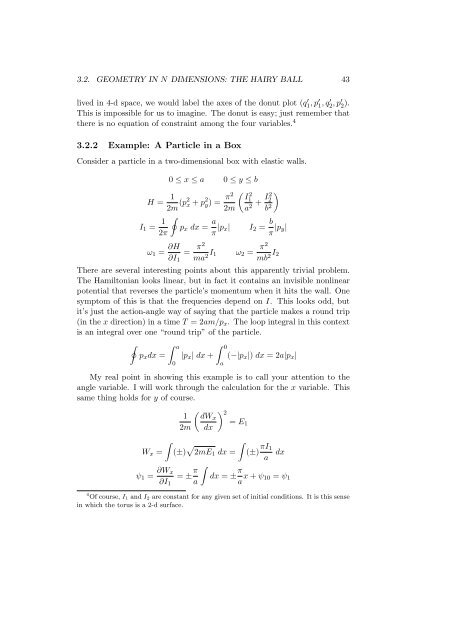Nonlinear Mechanics - Physics at Oregon State University
Nonlinear Mechanics - Physics at Oregon State University
Nonlinear Mechanics - Physics at Oregon State University
Create successful ePaper yourself
Turn your PDF publications into a flip-book with our unique Google optimized e-Paper software.
3.2. GEOMETRY IN N DIMENSIONS: THE HAIRY BALL 43<br />
lived in 4-d space, we would label the axes of the donut plot (q ′ 1 , p′ 1 , q′ 2 , p′ 2 ).<br />
This is impossible for us to imagine. The donut is easy; just remember th<strong>at</strong><br />
there is no equ<strong>at</strong>ion of constraint among the four variables. 4<br />
3.2.2 Example: A Particle in a Box<br />
Consider a particle in a two-dimensional box with elastic walls.<br />
0 ≤ x ≤ a 0 ≤ y ≤ b<br />
H = 1<br />
2m (p2x + p 2 y) = π2<br />
(<br />
I2 1<br />
2m a2 + I2 2<br />
b2 )<br />
I1 = 1<br />
<br />
px dx =<br />
2π<br />
a<br />
π |px| I2 = b<br />
π |py|<br />
ω1 = ∂H<br />
∂I1<br />
= π2<br />
I1 ω2<br />
ma2 = π2<br />
I2<br />
mb2 There are several interesting points about this apparently trivial problem.<br />
The Hamiltonian looks linear, but in fact it contains an invisible nonlinear<br />
potential th<strong>at</strong> reverses the particle’s momentum when it hits the wall. One<br />
symptom of this is th<strong>at</strong> the frequencies depend on I. This looks odd, but<br />
it’s just the action-angle way of saying th<strong>at</strong> the particle makes a round trip<br />
(in the x direction) in a time T = 2am/px. The loop integral in this context<br />
is an integral over one “round trip” of the particle.<br />
∫ a ∫ 0<br />
pxdx = |px| dx + (−|px|) dx = 2a|px|<br />
0<br />
My real point in showing this example is to call your <strong>at</strong>tention to the<br />
angle variable. I will work through the calcul<strong>at</strong>ion for the x variable. This<br />
same thing holds for y of course.<br />
1<br />
2m<br />
a<br />
( ) 2<br />
dWx<br />
= E1<br />
dx<br />
∫<br />
Wx = (±) √ ∫<br />
2mE1 dx =<br />
ψ1 = ∂Wx<br />
∂I1<br />
= ± π<br />
∫<br />
a<br />
(±) πI1<br />
a dx<br />
dx = ± π<br />
a x + ψ10 = ψ1<br />
4 Of course, I1 and I2 are constant for any given set of initial conditions. It is this sense<br />
in which the torus is a 2-d surface.
















